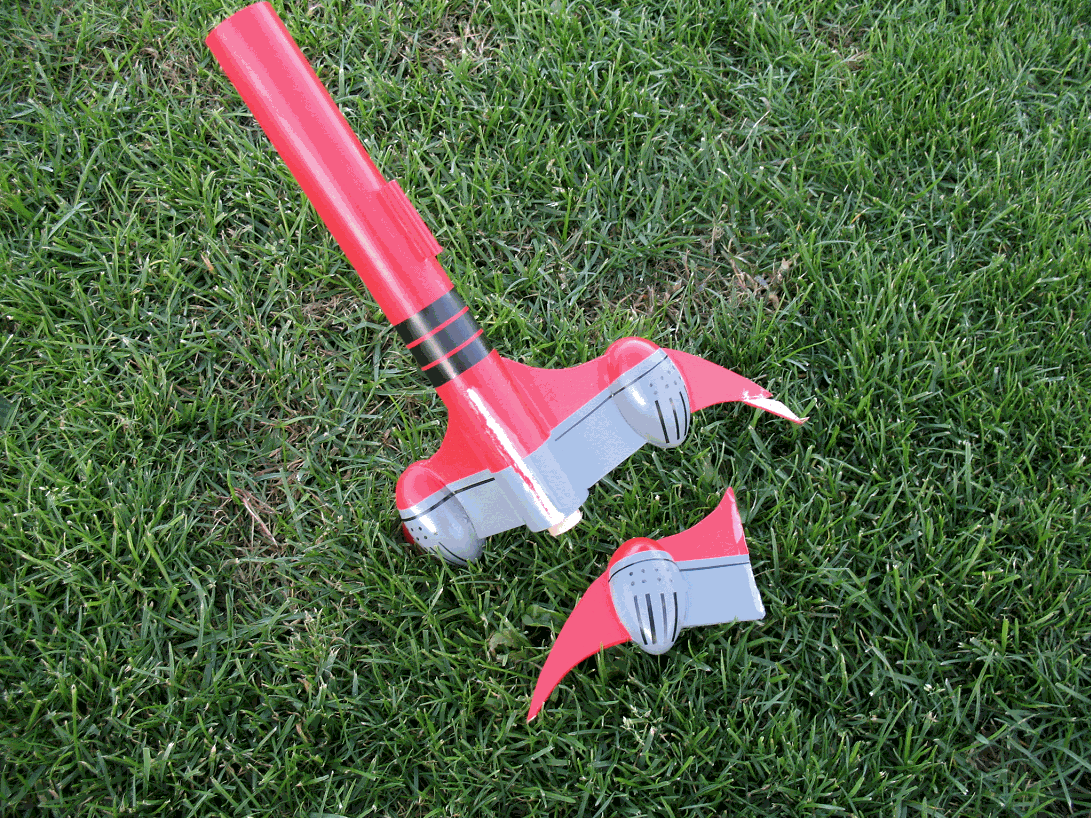Scratch Red Bolt Original Design / Scratch Built
Scratch - Red Bolt {Scratch}
Contributed by Andrew Skinner
| Manufacturer: | Scratch |
EMRR Spaceship Design Contest Entry
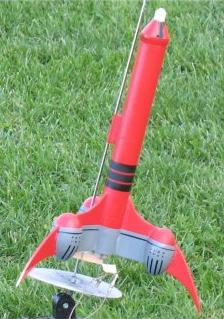
"The Red Bolt"
Material’s needed
- 3 Silly Putty Container Eggs
- 1 27.2 cm BT-50 body tube
- 1 BT-20 Engine Mount Tube
- 1 Engine Hook Note: This hook
- has each tip bent back so as to serve as an Engine Block
- 1 Weird nose cone we salvaged from an old kit. (Close up pic included.)
- 2 BT-50 Centering Rings
- 3 1/8 thick fins. (Template provided)
- 1 4 cm launch lug
- 1 h: 0.5 cm, l: 4.0 cm, w: 0.2 cm
- 1 Estes Hexagon Parachute with shrouds (52 cm in diameter)
- 1 rubber shock cord (Approximately 28 cm long)
- 1 Shock Cord Mount
#1: Engine Mount
- Cut a 5 mm slit, 3 mm from the end of the tube.
- Insert one of the ending hooks of the Engine hook into the slit.
- Glue down the engine hook.
- Glue on a centering ring at 2.5 cm from the aft of the engine tube.
- Glue on 2nd centering ring on top of the engine hook at the slit 3mm from the forward section of the Engine tube.
- Allow to dry.
- Wrap piece of masking tape around the Engine Tube securing the Engine hook to the Engine Tube.
- Apply a ring of glue approximately 5 cm inside the Rocket’s Body Tube.
- Place Engine Mount inside Rocket’s Body Tube until the Engine Tube is flush with the Rocket’s Body Tube.
- Apply glue to centering rings. Allow to dry
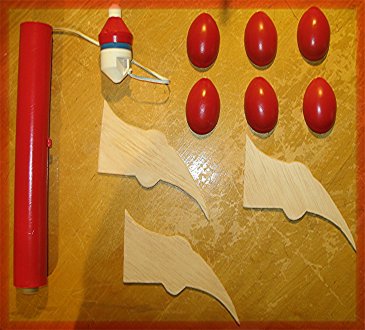 #2: Silly Putty Eggs
#2: Silly Putty Eggs
- Buy 3 Silly Putty Eggs
- Cut the connector tabs with a hobby knife.
- Then sand the raised writing off the top.
#3: Fins
- Using the template provided trace out the wing pattern on a 1/8 balas wood.
- Using a hobby knife cut out the fins.
- Sand down all jagged edges.
- Glue on Silly putty eggs onto the matching shape on the fins. Glue one on each side of each fin.
- Glue on several fillets to ensure that egg-fin contact is perfectly sealed.
- Mount the fins flush against the end of the body tube using a fin mount. We used the fin mount for 3 fins provided in The Handbook of Model Rocketry 7th edition on page 38. The fins should be 120 degrees from each other.
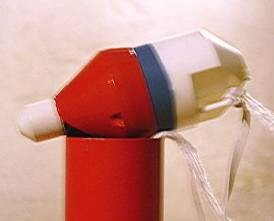 #4. Nose and
parachute mount.
#4. Nose and
parachute mount.
- Cut out a Shock cord mount using stiff paper.
- Glue shock cord on to shock cord mount.
- Glue Shock cord mount approximately 5 cm inside the forward part of the body tube.
- Tie free end of shock cord to the nosecone’s eyelet. Apply a drop of glue to the knot.
- Attach parachute to the nosecone eyelet.
#5. Launch Lug
- Glue on the h: 0.5 cm, l: 4.0 cm, w: 0.2 cm piece of balsa wood 10 cm from the forward end of the body tube. Make sure that it is aligned parallel to the body tube, and also make sure that it is in between the fins.
- Attach Launch Lug on top of the strip of balsa wood. (Note: The reason for the strip of balsa wood is to elevate the launch lug so as to provide the launch rod clearance from the nose cone. The nose at one section is wider than the body tube)
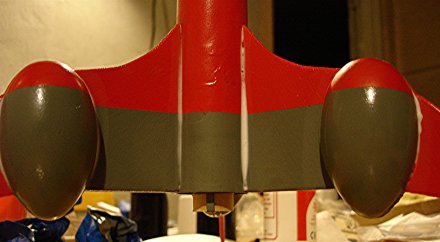
#6. Paint job
- Spread balsa filler over the fins. Allow to dry and than sand excess off.
- Sand all external parts of rocket.
- Prime all external parts of rocket
- Paint body tube, fins, and nose cone red.
- Paint Silly putty eggs gray.
- Nose cone
- First painted the whole nosecone red
- Paint the upper cap white.
- Paint 2 keyhole shapes on opposite sides of nosecone.
#7. Body tube and launch lug
- Painted body tube red. As well as the launch lug and balsa wood strip.
- Paint 3 parallel black rings approximately 2 mm from each other. Paint them approximately 9.3 cm from the aft end of body tube.
- Paint a single gray ring around the aft end of the body tube. It should 3.3 cm from the end of the tube, and it should encircle around the whole tube.
#8. Fins
- Paint fins red.
- Paint gray rectangle on each side in the corner by the fin root edge. The rectangle should be 3.3 cm high and should be around 4 cm wide. If it is a little bit wider than 4 cm it is okay, because the Silly Putty eggs will cover the excess. (Note: This is easier done if you paint before initial construction.
#9. Silly Putty eggs
- Paint egg shell red.
- Once the red paint is dry, paint most of the egg grey. The grey should cover 5.2 cm of the egg, starting from the bottom. There needs to be 1.4 cm of red.
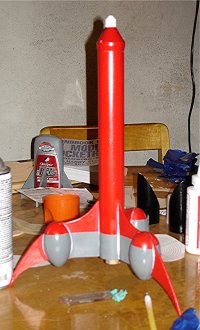 #10. Decal
stickers.
#10. Decal
stickers.
- Take black sticky paper, and cut into 2.5 cm long by 1 mm strips. Stick 4 of these length wise on each egg.
- Then once again using the black sticky paper cut several long 1 mm strips for the black stripe that runs across the egg and the fin.
#11. Black Dots
- Use a black permanent maker to apply 8 dots to each egg shell.
#12. Nose Weight and Motor
- Add 25-30 grams of clay to the nose.
- We used a B6-4 all of the launches, but a B6-2 would have been better.
Flights
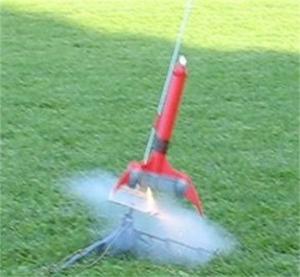
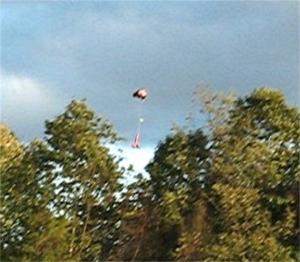
Takeoff off. Flight #1 (above). Landing…..
Success flight. No damage rendered to rocket.
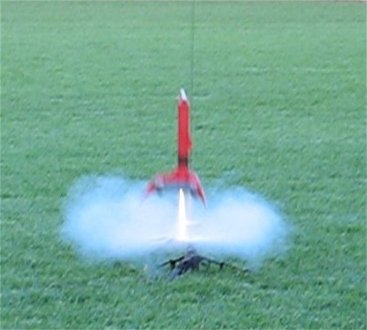
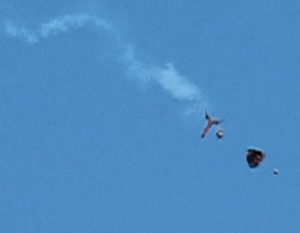
Takeoff off. Flight #2 (above). But disaster strikes when the shock cord snaps!!
And lawn darts (below). Note: We have not touched the rocket yet in this picture. It landed exactly like this. Note that the third fan, the one stuck in the ground, is still intact. Nose and parachute land a couple hundred feet away. The rocket is now repaired and waits for its next launch.
Here is our video of the 2 launches. Ignore our screams in the background!
Here are two more successful flights of our entry the Red Bolt. We only have videos for these launches:
 |
 |
